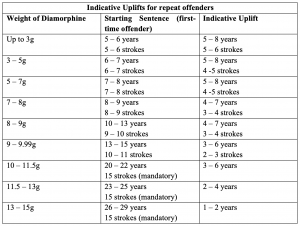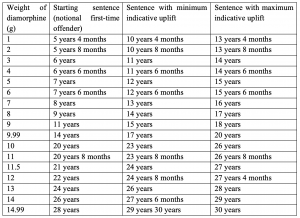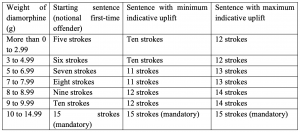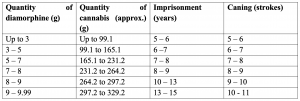CJC-F, CJC-F Announcements, CJC-F Understanding Forensics, CLD Criminal Law Basics, Uncategorized
INTRODUCTION
In the previous article “Singapore’s Misuse of Drugs Act – A Primer” (https://nuscriminaljustice.com/singapore-misuse…ugs-act-a-primer/), the basic statutory rules governing certain offences set out in the Misuse of Drugs Act, that of possession, consumption, trafficking and importation, were summarized. This article seeks to briefly summarise how the Court uses the sentencing ranges, referred to in the previous article, to sentence an offender.
In this regard, the Courts have developed certain sentencing frameworks for certain drugs, so that both the Prosecution and the accused person would know what ought to be the rough estimate of the sentencing range that an accused person would be liable to.
There is a large variety of drugs that are present in the world. Thus, not all the frameworks that have been established by the Courts will be covered here. Further, the Courts have not set out sentencing frameworks for all the drugs as not all the drugs have involved a conviction in a Court of law. Even if there are such convictions, they do not occur often enough to warrant a sentencing framework for that particular drug.
For the avoidance of doubt, the frameworks set out below concern that of trafficking of three drugs, namely diamorphine, cannabis and methamphetamine. This is because they are relatively common in occurrence, alongside consumption which is governed by the MDA. In addition, among the four offences discussed in the previous article, trafficking is the one which has the most substantial case law.
This article is written with the idea of introducing readers the basic rules and laws surrounding judicial frameworks.

Source: https://www.lawcrossing.com/images/articleimages/Legal-Writing-Guidelines-for-Law-Students-and-Attorneys.jpg
UNDERLYING RULE INVOLVING FRAMEWORKS
Before going into the specific sentencing frameworks, one must always consider the rule set out in the case of Dinesh Singh Bhatia s/o Amarjeet Singh v PP (“Dinesh Singh Bhatia”) where the High Court explicitly stated that sentencing frameworks help to achieve a certain degree of “consistency and rationality in our sentencing practices.” However, the Court warned that such sentencing practices “ought not, however, to be applied rigidly or religiously” as “[n]o two cases can or will ever be completely identical or symmetrical.”
Thus, one should always note that no sentencing framework is ever to be applied rigidly. An accused person may be sentenced to a term of imprisonment that is far higher or lower than the prescribed band/tier (as will be set out below). This is due to the existence of several aggravating or mitigating factors that may be in existence, such as, possibly, where the profit that a drug offender may obtain from his activities is particularly lucrative or where there is an early plea of guilt by the accused.
Thus, one should always remember that the sentencing frameworks set out by the Courts are not set in stone.
THE DETERMINATION OF FRAMEWORKS
The following section will briefly cover some of the sentencing frameworks that have been with regard to the offence of trafficking. Note that this also includes instances of possession with the purposes of trafficking.
As a preliminary point, several things must always be considered when it comes to the sentencing of a trafficking charge. First, the starting point would naturally be the quantity of drugs that was involved in the trafficking charge. As explained in the seminal case of Vasentha d/o Joseph v PP (“Vasentha”), the quantity of drugs, as measured in terms of its net weight, that has been trafficked would have a direct correlation with the degree of harm to society. However, other factors must also be considered such as the culpability of the offender and the presence of aggravating or mitigating factors.
This was also supported by the Court of Appeal in Suventher Shanmugam v PP where the Court emphasised that the sentence passed for a crime should be proportional to the gravity of the offence. For offences concerning the trafficking and importation of drugs, the gravity of the offence is measured by the quantity of drugs involved. Second, when determining what ought to be the appropriate indicative starting point of an offence, the Court in Vasentha took into account three considerations.
First, the maximum sentence is usually reserved for the “worse type of cases falling within the prohibition” and the courts would impose a sentence close to or fixed at the statutory maximum only if the offender’s conduct is “among the worst conceivable for that offence”, citing the cases of Angliss Singapore Pte Ltd v PP and Sim Gek Yong v PP. The sentence must correspond to the seriousness of the offence and that requires an examination of not only the harm but also the culpability of the offender and other relevant circumstances. The starting points should thus leave room for the sentencing judge to adjust the sentence upwards or downwards where required.
Secondly, the cases ought to fully utilise the full spectrum of possible sentences, and thus, the indicative starting points ought to span a range of possible sentences that stop short of the statutory maximum sentence. For the present purposes, this would mean the sentences set out in the Second Schedule of the MDA. Lastly, due to the importance of the degree of harm as a sentencing consideration, the starting points should be broadly proportional to the quantity of the diamorphine. In other words, the greater the quantity, the higher the sentence.

Source: https://ars.els-cdn.com/content/image/3-s2.0-B978012800213100081X-f81-01-9780128002131.jpg
TRAFFICKING OF DIAMORPHINE
The first offence is that of trafficking of diamorphine. If an offender is carrying between 10 and 15 grammes of diamorphine, the statutory sentencing range of a minimum of 20 years imprisonment and a maximum of 30 years imprisonment, or life, along with 15 strokes of the cane, would be applicable to him.
What would then be the sentencing range if the offender is in possession of less than 10 grammes instead? This is explained in the above mentioned case of Vasentha, where the High Court set out the indicative starting points for first-time offenders who are trafficking in diamorphine, which has been banded according to the quantity:

The Court further explained that these are just indicative starting points, based on the quantity of the diamorphine. The second step of the determination would involve calculating and adjusting the amounts, where appropriate, to reflect the offender’s culpability along with the presence of any relevant aggravating or mitigating factors. Where no adjustment is necessary, the indicative starting point may then be the appropriate sentence to be imposed.
For cases where the offender is instead in possession of diamorphine that is greater than 9.99g, guidance can be obtained from the case of PP v Tan Lye Heng (“Tan Lye Heng”) where the Court set out the following indicative starting points for the custodial sentence for trafficking between 10g to 15g of diamorphine:
The offender would also be sentenced to the mandatory 15 strokes of the cane, as per the Second Schedule of the MDA.
The above concerns first-time traffickers of diamorphine. The exact same starting points cannot automatically apply for repeat offenders of trafficking, as explained in the case of PP v Lai Teck Guan (“Lai Teck Guan”). The Court explained that whether the principles of Vasentha are suitable for any given offence is dependent on whether the sentence hinged largely on a single metric, albeit later adjusted for other factors, or whether the gravity of the offence was or might have been affected by several metrics, each potentially of importance.
In cases of repeat offenders, Vasentha is not suitable as there were two important metrics that would feature in the sentencing analysis; the quantity of drugs and the circumstances in which the repeat offence came about. It is also difficult to derive a principled uplift from Vasentha, for repeat offenders, as the sentencing ranges for first-time offenders and repeat offenders do not mirror each other.
However, Vasentha is still useful and applicable when sentencing repeat offenders in the following way:
The sentencing court would first derive the starting point for the sentence based on the quantity of drugs for first-time offenders using Vasentha.
However, Vasentha is still useful and applicable when sentencing repeat offenders in the following way:
- The sentencing court would first derive the starting point for the sentence based on the quantity of drugs for first-time offenders using Vasentha.
- The Court would then apply an indicative uplift on account of the fact that this is a repeat offence and derive an indicative starting point on this basis, having due regard to the circumstances of the repeat offence.
- Finally, the court would adjust that indicative starting point based on the offender’s culpability and the aggravating or mitigating factors, which have not been taken into account in the analysis up to this point.
With the above in mind, the Court then set out the following indicative uplifts, after taking into account the starting points set out in Vasentha and Tan Lye Heng above:
However, the abovementioned starting points were revised by the High Court in Soh Qiu Xia Katty v PP (“Katty Soh”):
The caning sentences was also revised, as follows:
At this juncture, it is pertinent to note that all 3 of the decisions in Vasentha, Lai Teck Guan and Katty Soh were decided at the High Court level. As such, none of the cases overrule one another. The revisions made in Katty Soh from the decision made in Lai Teck Guan were referred to by the High Court in Mohd Akebal s/o Ghulam Jilani v PP where the Court made the following observations:
- First, guidelines are a means to an end and the relevant end is the derivation of sentences that are just and are broadly consistent in cases that are broadly similar.
- Second, sentencing guidelines are not meant to yield a mathematically perfect graph that identifies a precise point for the sentencing court to arrive at in each case. Rather, they are meant to guide the court towards the appropriate sentence in each case using a methodology that is broadly consistent.
- Third, sentencing guidelines are meant to be applied as a matter of common sense in the light of the foregoing observations.
The Court went on to say that the differences adopted in Katty Soh and Lai Teck Guan would not actually yield any difference in practice in the outcome and that they involve matters of detail that did not invite further comment. This view was also followed by the High Court in the case of PP v Poopathi Chinaiyah s/o Paliandi.
In other words, the aforementioned cases are still good law.
For completeness’ sake, if the offender is in possession of an amount of diamorphine greater than 15 grammes, they are liable to the death penalty.
Source: https://www.adamsluka.com/photos/orlando-cannabis-trafficking-attorneys.jpg
TRAFFICKING OF CANNABIS
The next offence is that of trafficking of cannabis. Unlike diamorphine, the Courts have been relatively consistent with regard to a sentencing framework for cannabis. If an offender is in possession of 330 grammes to 500 grammes of cannabis, they are liable to a sentencing range of a minimum 20 years’ imprisonment to a maximum of either 30 years or life imprisonment. The first relevant sentencing framework would concern the aforementioned range of 330 grammes to 500 grammes.
In that regard, the seminal case is the case of Suventher, where the Court referred to the case of Vasentha and recognised that it had been applied to other drugs apart from diamorphine. Whilst the Court recognised that the sentencing range in Vasentha cannot be applied wholesale, as they concern different factors and different drugs, the approach in Vasentha was still recognised as a useful guide to derive a sentencing range for cannabis. The following sentencing guidelines were then established, and were expressly held to be applicable to both the unauthorised import or trafficking of cannabis:
In addition, as per the Second Schedule, offenders who have trafficked more than 330g of cannabis are liable to the mandatory sentence of 15 strokes of the caning.
For amounts under 330g, it may be useful to refer to the case of PP v Sivasangaran s/o Sivaperumal (“Sivasangaran”) which was considered in Suventher and held in the 2020 District Court case of PP v Ng Gim Hui Amy (“Amy Ng”) to be consistent with one another. At this juncture, it is pertinent to note that the aforementioned case of Amy Ng was decided at the District Court level. Nevertheless, at the time of writing, it is still judicially recognised that the principles in Sivasangaran is consistent with those in Suventher.
In Sivasangaran, the Court had accepted the Prosecution’s sentencing framework, which was based on the indicative starting points set out in Vasentha for diamorphine, and which extrapolated similar starting points for use in trafficking in cannabis, as follows:
For the sake of completeness, if an individual is in possession of more than 500 grammes of cannabis, they are liable to be sentenced to death.

Source: https://www.bunburymail.com.au/images/transform/v1/crop/frm/silverstone-feed-data/e58dcde7-3ad8-4308-9fed-8bcac921e9ea.jpg/r0_0_800_600_w1200_h678_fmax.jpg
TRAFFICKING OF METHAMPHETAMINE
The last offence is that of the trafficking of methamphetamine. If an offender is in possession of between 167 grammes to 250 grammes of the substance, they are liable to a sentencing range of a minimum sentence of 20 years’ imprisonment to a maximum term of 30 years’ imprisonment or life, alongside a mandatory punishment of 15 strokes of the cane.
In establishing sentencing frameworks for the trafficking of methamphetamine, the Courts have extrapolated the rules of other cases, in particular Vasentha and Suventher and applied them to cases of methamphetamine.
In Loo Pei Xiang Alan v PP, the Court relied on the principles established in Vasentha and derived a “conversion scale” or rather, an “exchange rate” between diamorphine and methamphetamine. In doing so, the Court explained that the Second Schedule of the MDA prescribes the exact same minimum and maximum punishments for trafficking between 10g and 15g of diamorphine and trafficking between 167g and 250g of methamphetamine. Thus, this means that, all other things being equal, an offender who traffics between 10g and 15g of diamorphine is to be considered as culpable as a person who traffics between 167g and 250g of diamorphine. Thus, the culpability of an offender who traffics one gram of diamorphine is equivalent in culpability to an identically-situated offender who traffics 16.7g of methamphetamine. In that case, the Court applied the aforementioned conversion scale and held that trafficking 11.64g of methamphetamine is an act of equivalent culpability to trafficking 0.70g of diamorphine. Upon application to the framework in Vasentha, as set out above, that quantity of diamorphine would then fall within the lower end of the lowest band of sentences, thereby encompassing quantities under 3g. Had the offender in this case been a first-time offender, the indicative starting point for trafficking 11.64g of methamphetamine would instead be five to six years’ imprisonment and five to six strokes of the cane.
On the other hand, in Adri Anton Kalangie v PP (“Adri”), the Court had extrapolated a sentencing framework for the trafficking or importation of 167g to 250g of methamphetamine from the Suventher framework and set out the following indicative starting sentences:
In holding as such, the Court in Adri referred to the case of Pham Duyen Quyen v PP wherein the Court of Appeal held that the sentencing ranges for cannabis, as set out in Suventher, could also apply to offences involving other drugs where the range of prescribed punishment is the same. As the prescribed punishment for methamphetamine is the same as cannabis, the sentencing ranges could be extrapolated.
For the sake of completeness once again, it bears reminding that if an individual is in possession of more than 250g of methamphetamine, they are liable to the death penalty.
CONCLUDING THOUGHTS
The Courts have made sentencing frameworks for a variety of offences, and not just the aforementioned drug offences. These frameworks are very helpful in that they allow all parties to know what the relevant starting points for the relevant offences would be. This in turn allows for greater consistency in judicial decisions which eventually allows for easier understanding of the laws surrounding drug offences in Singapore.
Though the sentencing frameworks are helpful, one should also always note the decision in Dinesh Singh Bhatia where the Court expressly stated that sentencing frameworks are never to be followed rigidly and there must always be some degree of flexibility.
One should also note how the above does not take into consideration the second step of the determination of a sentence for an offender, which is the adjustment of the sentence with regard to the culpability of the offender and the presence of any aggravating or mitigating factors of the accused. Such factors differ between offenders and between cases and it is impossible to properly state how high or how low a sentence will be adjusted in light of those factors. There is thus no rule that the Court must stick within a particular band of punishment. It of course goes without saying that any punishment imposed cannot go below the relevant statutory minimums.
In conclusion, the establishment of sentencing frameworks have been particularly helpful in the hearing of drug cases, though they are not determinative. It is entirely possible for further sentencing frameworks to be developed for other drugs or illicit substances, such as for synthetic substances.
*The views and opinions expressed in this article do not constitute legal advice and solely belong to the author and do not reflect the opinions and beliefs of the NUS Criminal Justice Club or its affiliates.

Mohamed Sarhan is a Year 3 Law Student in NUS Law and is one of the Project Managers of “Drugs & Forensics”. He is in charge of facilitating the activities within the project and hopes to evolve the project to a greater stage. Though still a student, Sarhan has assisted in a variety of criminal law cases and wants to use his knowledge to educate others about drug laws in Singapore. He hopes that his efforts in the project will enlighten others about the law’s position on drugs and the plight of drug offenders.
Muhammad Khairul Fikri is a Year 3 undergraduate from the Faculty of Arts and Social Sciences. Khai is one of the Project Managers of “Drugs & Forensics”. He is pursuing a Major in Geography and two Minors; Forensic Science and Geographical Information Systems. He is interested in the applications of technology, particularly geospatial technologies, in forensic science and crime scene investigations.

